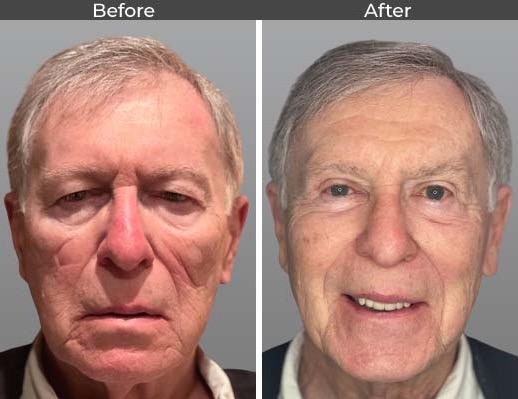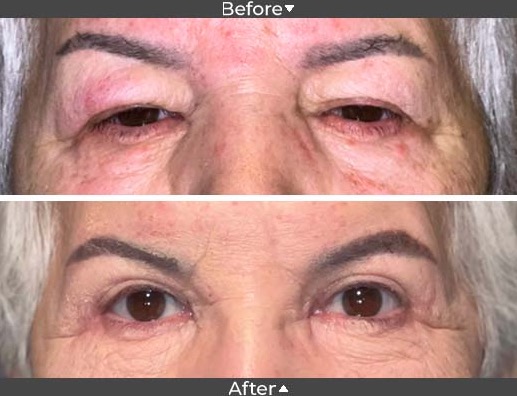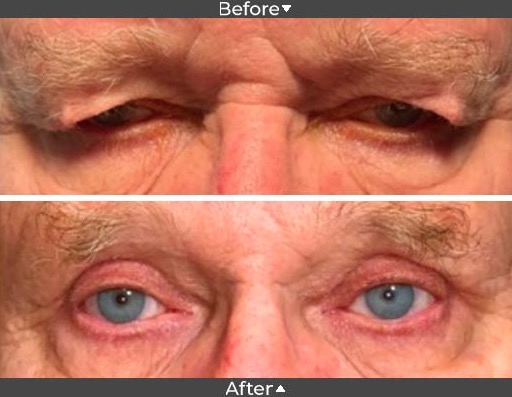
What is ptosis?
Ptosis is when one or both of your UPPER eyelids droop downward. This can vary from slight drooping that is hardly noticeable to significant drooping that covers the pupil—in severe cases, affecting your field of vision.
Ptosis occurs when the muscles that raise the eyelid are not strong enough or when the nerve that controls these muscles doesn't work correctly. It can affect one or both eyes.
- What are the causes of ptosis?
- Droopy eye from ptosis can cause:
- How is ptosis treated?
- What is ptosis surgery?
- Who should perform ptosis surgery?
- What to expect after an eyelid ptosis repair surgery
- Why Choose Assil Gaur Eye Institute for your ptosis surgery near you?
- Ptosis FAQs
- What are the risks of ptosis correction surgery?
- What’s the difference between blepharoplasty and ptosis surgery?
- Can ptosis cause a lazy eye?
- Can wearing contact lenses cause ptosis?
What are the causes of ptosis?
The causes and severity of ptosis vary significantly from patient to patient, so each procedure must be meticulously tailored to the individual's specific needs and anatomy. Numerous things can be the source of ptosis, including:
- Aging, as ptosis usually develops later in life
- An injury
- A medical condition, such as a stroke, Horner’s syndrome, myasthenia gravis, diabetes, skin cancer around the eye, benign lesions, or a stye.
- Being born with it is called congenital ptosis.
Droopy eye from ptosis can cause:

- A tired appearance or sleepy-looking
- Eye strain or headache: Some people with ptosis raise their eyebrows unconsciously to try to lift their drooping eyelids, which can eventually cause forehead discomfort or headaches.
- Trouble seeing: some people may have to tilt their heads back to see under the eyelid.
- Dry or watery eyes
How is ptosis treated?
Treatment for ptosis depends on its cause and severity, as well as the patient's age and general health.
Our doctor might recommend a wait-and-see approach in mild cases of ptosis that don't interfere with vision. Regular check-ups are necessary to ensure the condition doesn't worsen over time.
Surgery is the preferred treatment option when ptosis interferes with vision or poses a cosmetic concern.
What is ptosis surgery?
The good news is that surgery to elevate the eyelid can correct ptosis. Ptosis surgery is an outpatient procedure that can be performed under local anesthesia in our surgery center. Our patients go home the same day.
There are three different surgical procedures for lifting the upper eyelid into its proper position. Our surgeon tightens the levator muscle during the procedure to help lift the eyelid. If the levator muscle is extremely weak, the surgeon might attach or suspend the eyelid from smaller muscles in the eyebrow so the forehead muscles can lift.
Schedule your consultation today with our internationally recognized oculoplastic surgeons.
Who should perform ptosis surgery?

Ptosis correction surgery is considered one of the most challenging eyelid surgeries today. It must be performed by a highly experienced, board-certified Oculoplastics surgeon and requires exceptional precision and an individualized approach.
When performed by an experienced board-certified oculoplastics surgeon like Dr. Adeleh Yarmohammad and Dr. Rafi Israel, the procedure is considered a permanent solution for ptosis. Revision surgeries are rarely necessary.
What to expect after an eyelid ptosis repair surgery
Following your surgery, you will be asked to limit your activities for a week to allow the eyelid muscles and soft tissues to heal. You’ll be advised to avoid rubbing or doing anything irritating your eyes. Bruising and swelling can last from three to four weeks.
Since a ptosis repair can make your eyes more prone to dryness, our doctor will prescribe medications to keep them adequately lubricated during this time.
You will have periodic follow-ups during your recovery so our surgeons can check changes in your eyelid position as your post-op swelling subsides.
If the lid position is not ideal once you are fully healed, our surgeon can perform minor adjustments to reduce sagging and elevate the eyelid to the desired level.
Why Choose Assil Gaur Eye Institute for your ptosis surgery near you?
Your eyes are one of the most delicate structures in your body. That’s why, when you’re looking for a Los Angeles area surgeon to correct the appearance or function of your eyelids and the structures surrounding your eyes, you want to seek an oculoplastic surgeon.
In contrast to a plastic surgeon, an oculoplastic surgeon is an ophthalmologist with extensive training in microsurgical eye surgery followed by highly specialized training in ophthalmic plastic and reconstructive surgery. The health and safety of your eyes are the number one priority in all surgical planning performed by an oculoplastic surgeon.
As trained ophthalmologists, board-certified Dr. Adeleh Yarmohammad and Dr. Rafi Israel have extensive experience treating functional eye problems that affect patients’ vision and eye health, performing cosmetic procedures, and revising surgeries that have gone wrong elsewhere.
Please schedule a consultation with us at our Beverly Hills or Santa Monica clinics to discuss the appearance or function of your eyelids. Please call 866-945-2745 or click here to request an appointment online.
Assil Gaur Eye Institute is conveniently located for patients throughout Southern California and the Los Angeles area, including Beverly Hills, Santa Monica, West Los Angeles, West Hollywood, Culver City, Hollywood, Venice, Marina del Rey, Malibu, Manhattan Beach, and Downtown Los Angeles.
Ptosis FAQs
What are the risks of ptosis correction surgery?
While all surgeries have associated risks, many of the risks of ptosis eyelid lift surgery can be avoided by finding the right surgeon. Surgeons must accurately adjust the levator muscle (the small muscle that moves the upper eyelid up and down), which lifts the eyelid, to achieve a balanced and natural appearance. Even a small error can result in asymmetry.
The primary risk associated with a ptosis rejuvenation surgery is that the level of your open upper lids does not appear symmetrical; in other words, they’re at different heights even though they are more elevated than before surgery.
Another complication can be dry eyes resulting from incomplete closure of the eyelids, resulting in dry eye problems.
What’s the difference between blepharoplasty and ptosis surgery?
While blepharoplasty focuses on removing excess eyelid skin, the goal of ptosis surgery is to tighten the levator muscles to eliminate drooping of the upper eyelid.
Can ptosis cause a lazy eye?
Yes, eye ptosis can contribute to developing a “lazy eye,” also known as amblyopia. This condition occurs when one eye fails to develop regular sight during early childhood, often due to that eye not receiving fair use.
This is one reason to choose whom to perform plastic surgery on your eyes carefully. Ptosis is not simple cosmetic surgery by any means. For this reason, we urge you to seek out an oculoplastic ophthalmologist.
Can wearing contact lenses cause ptosis?
Long-term use of contact lenses has also been associated with ptosis. One theory suggests that inserting and removing contact lenses might stretch the levator muscle over time, weakening it and causing the upper eyelid to droop.
Cosmetic eye procedure articles from our blog
-
Dr. Adeleh Yarmohammadi (known as "Dr. Adele" by our team) is a highly skilled ophthalmologist offering our patients facial aesthetic, cataract, glaucoma, and LASIK procedures. During her residency training at University of California, San Diego’s world-renowned Shiley Eye Institute, she developed her expertise in Oculoplastics and in Anterior Segment surgery.
While there, Dr. Adele was honored by being selected as the program’s Chief Resident from an impressive field of young physicians. She then completed a glaucoma and anterior segment fellowship at UC San Diego under the direction of Dr. Robert Weinreb, one of the world’s most prominent leaders in Ophthalmology and the very same physician who had previously trained Dr. Assil. We are thrilled to have her join the Assil Gaur Eye Institute, where our patients will benefit from her superb judgment, surgical skills, and compassionate care.














